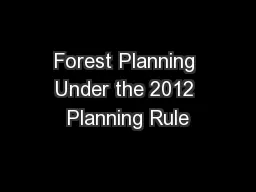

Maximillian Wahlberg Regional Analyst Phases of Planning Direction comes from the Planning Rule as well as Directives Phases of Planning PreAssessment Not a formal planning step where we are currently ID: 559738
Download Presentation The PPT/PDF document "Forest Planning Under the 2012 Planning ..." is the property of its rightful owner. Permission is granted to download and print the materials on this web site for personal, non-commercial use only, and to display it on your personal computer provided you do not modify the materials and that you retain all copyright notices contained in the materials. By downloading content from our website, you accept the terms of this agreement.
Slide1
Forest Planning Under the 2012 Planning Rule
Maximillian Wahlberg – Regional AnalystSlide2
Phases of Planning
Direction comes from the Planning Rule
as
well as Directives
Phases of Planning:
Pre-AssessmentNot a formal planning step – where we are currentlyAssessment -> Need for ChangeEvaluation of current conditions and projected trendsPlan Development and AlternativesMonitoring
Primary Analysis PhasesSlide3
The Assessment
Contributions to ecological integrity are assessed for “key ecosystem characteristics”
For each characteristic:
Current conditions are compared to reference conditions (NRV)
Projected future conditions are compared to reference conditions (NRV)Note: NRV is used as a metric for sustainability; it does not necessarily represent a desired condition
Assessments feed Need for Change which in turn feed plan development and alternatives Slide4
Sideboards and Spatial Scales
Analytical tools, models and frameworks should:
Help evaluate current conditions against natural range of variation (NRV/HRV)
Provide a mechanism to project trends under current management (and differentiate from legacy management impacts)
Be scalable to broad landscapes
Sufficient to inform a Forest’s context/niche
Facilitate all lands analysis
Use readily available (or in limited cases rapidly attainable) information
Data inputs need to be appropriate for the scale at which questions are being asked and answered